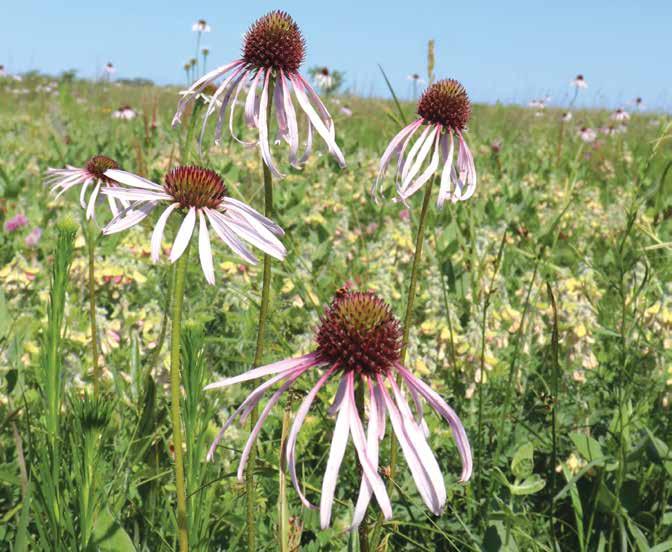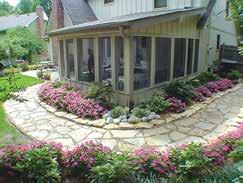
6 minute read
Native Plant Roots
Photo by Shaw Nature Reserve.
Pale purple coneflower (Echinacea pallida) at Penn. A total of 289 plant species have been recorded at the Missouri Prairie Foundation’s 160-acre, original, unplowed Penn-Sylvania Prairie in Dade County, MO. In July 2018, botanists identified 46 native species in a 20 x 20 inch frame, setting a new world record for plant richness at this scale.
To say that native plants have deep roots is like saying all Italians are great cooks, all goldfish are gold, and all cats are white with black spots. These statements are sometimes true, but definitely not always.
Plants on earth have evolved and adapted to grow in almost every environment and soil type. To do this, they have diverse root anatomies. Some roots are fine, dense, and shallow (sedges and azalea, for instance), others are coarse—like jump ropes—spreading out wide (like wild indigo and redbud), and yet others grow like a carrot, with a trunk that shoots straight down as far as it can go (e.g., prairie dock and compass plant).
I think the misconception that native plants have deep roots stems from studies that came out of the tallgrass prairie region where plant roots were excavated to a depth of 10 feet or more. In many areas of the Midwest, prairie soil is very deep, the result of ten thousand years of plant growth cycles, where roots expanded during periods of optimal growth and died back slightly during periods of flood or drought. These cycles distributed organic matter (compost) deep in the soil column, generating rich, fertile soils throughout the heart of the tallgrass prairie region. Today it grows the richest corn and soybean crops in the world.
A more accurate way to look at native plant roots (or for that matter, roots of plants anywhere) would be to think of each species as being vertically and horizontally territorial underground. For example, there The root of a 15-year-old compass plant (Silphium laciniatum), dug from Shaw Nature Reserve with a back hoe.
are many species living closely together in ancient remnant tallgrass prairies (miraculously some still exist). For example, the Missouri Prairie Foundation’s Penn-Sylvania Prairie holds the world record for plant diversity on a fine scale, with 46 native species documented within a 20 by 20 inch frame.
One reason that they can live so close together is that each species is vertically segregated. Some species grow deep (culver’s root and leadplant); some lie shallow at the surface (strawberry and pussy
SCOTT WOODBURY Horticulturist
Horticulturist Scott Woodbury is the Curator of the Whitmore Wildflower Garden at Shaw Nature Reserve in Gray Summit, MO, where he has worked with native plant propagation, design, and education for 28 years, and which is supported by the Missouri Dept. of Conservation. He also is an advisor to the Missouri Prairie Foundation’s Grow Native! program.

Prairie roots come in many forms, from thick taproots to fine networks. Note the shallow roots of non-native turf grass, at far left.
toes); and others take the middleground (goldenrod and aster). The other way they can exist so close together is through horizontal mixing, where coarse rhizomatous root systems (common milkweed and plains slough sedge) weave between fine-textured root networks of other grassland species. And then there are plants that have bulbs, corms and tubers, which are compressed underground plant stems that go dormant for part of the year (wild hyacinth, onion and lily).
These plants are also woven between shallow, fine-textured root networks close to the surface. When they go dormant, their roots died back, adding organic matter into the topsoil. All plants do this to some degree. Underground roots and stems grow and die annually from fluctuating soil moisture, winter freeze and thaw, and interactions with micro-organisms like bacteria, fungi, algae, protozoa, and many types of invertebrate animals living in the soil.
Some beneficial organisms transform dead plant roots and stems into usable forms of nutrients. Others graft onto plant roots to form conduits for nutrient and water uptake, and others protect plants against disease and root foraging by pests.
It’s no wonder why diverse tallgrass prairies are so hard (or impossible) to recreate. The most diverse part of the prairie (or any remnant ecosystem) is below ground. Try to picture a teaspoon of soil, harboring over a billion organisms, which prairie soil does. Restoration biologists and horticulturists are busy scratching their heads, trying to figure out how to replicate this in reconstructed plant habitats, built landscapes, and gardens. As you can imagine, this area of study is in its infancy and there is still much to learn and discover. But as for plant root anatomy, there is consensus among experts. Plant roots come in all sizes and shapes and they are critical for rainwater infiltration into the soil. That’s why rainwater runs over the surface of mowed lawns, but moves down into the soil where there are taller plants. Turf roots are about three inches deep, compared to the roots of garden plants, that may be two to three feet deep, depending on how deep the topsoil is. In construction areas (like around your house), topsoil is shallow or gone altogether.
It takes years for topsoil to improve. It doesn’t improve much if all you grow is lawn, but if you introduce a diversity of plants, you will find that slowly, organic matter will increase, compaction will decrease, plant roots will grow deeper, and rain water will move into the topsoil quicker. It may take a decade for topsoil to noticeably improve, so adding several inches of topsoil or tilling compost into the soil surface of new gardens will improve topsoil faster.
So next time you hear that native plants have deep roots, think again. After all, not all goldfish are gold.
Established 1975
FREE Estimates!
Customer Satisfaction Guaranteed
♥ 816-392-4433 ♥ 816-618-3674
Debbieslawnbusters.com

Improving our planet one customer at a time.
JOHNSON COUNTY TOPSOIL & LANDSCAPE MATERIALS, LLC

TOPSOIL • GARDEN MIXES
BULK MULCH • FLAGSTONE
WALLSTONE • BOULDERS

RIVER GRAVEL • WATER GARDEN ROCK
913-681-2629
2 BLOCKS WEST OF US69 ON 199TH ST. STILWELL, KS
WWW.JOHNSONCOUNTYTOPSOIL.COM
A Gardener’s Destination
Welcome Fall with Mums! Mums and Grass Planters • Pansies and Fall Bulbs Iris • Peonies • Onion and Garlic • Fall bedding plants
Now is the perfect time to plant trees and shrubs for beautiful fall color!
NEW arrivals of Fall décor, Pumpkins, Wreaths, Planters and more v Beautiful trees and shrubs v Elegant roses and perennials v Fertilome fertilizers and Fox Farms Products v Birdhouses and feeders v Wind chimes, pottery, urns, statuary, lanterns, wrought iron décor
112 E. Green St. • Clinton, MO 64735 • 660-885-3441 • Mon-Fri 8-6, Sat 8-4
10% discount with complete kit
We love bringing paradise to life with each water feature we build but also love assisting YOU in purchase doing the same. You will find everything you need to build the water feature of your dreams in one location. We will even help you determine pump size, amount of liner, and explain our filtration system and its benefits. Now is the time.. create paradise in your own backyard! Call or visit our retail location for more information.











